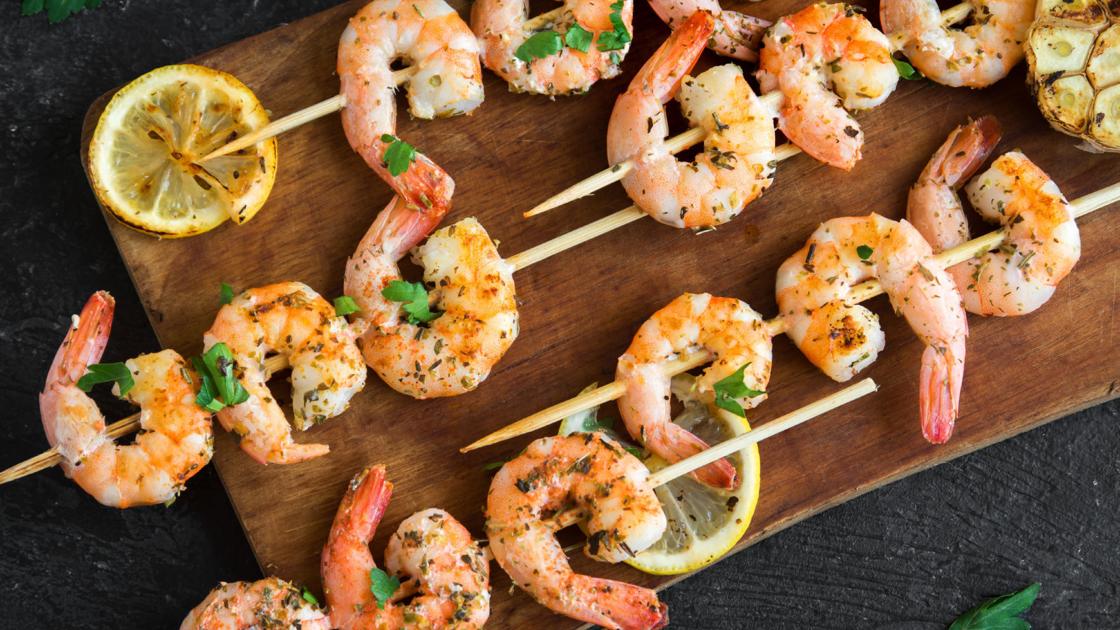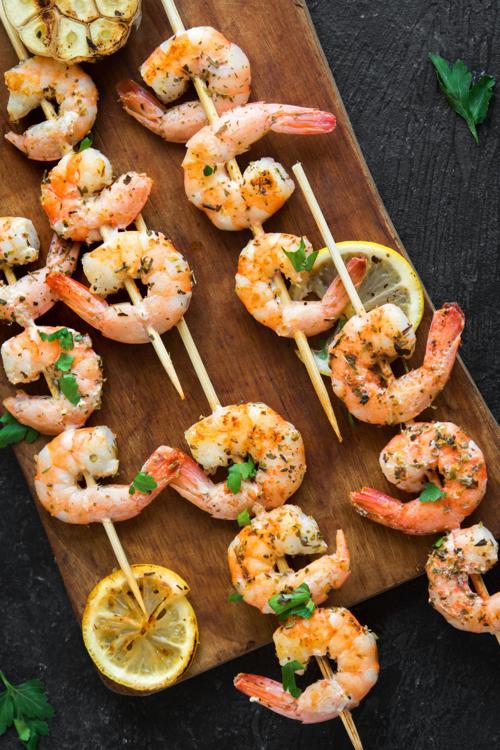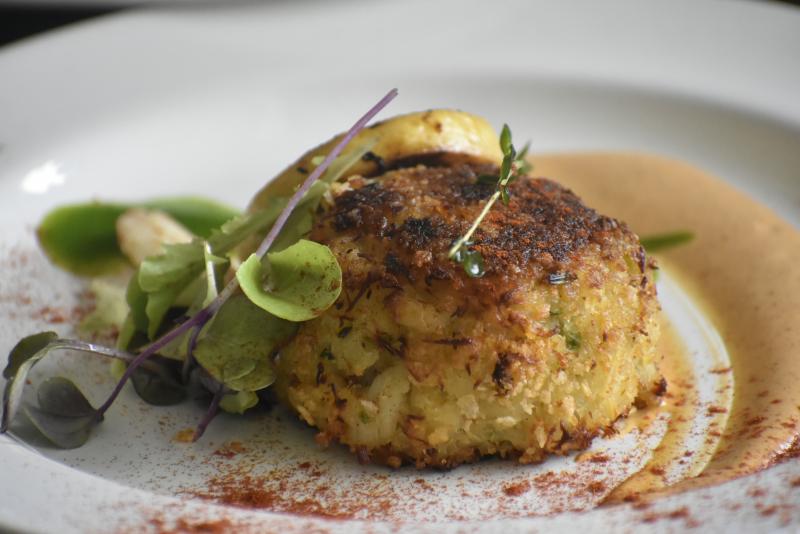

These kabobs are made with shrimp, which live exclusively in salty sea water. Unseasoned shrimp have a slightly saltier, savory taste. Prawns, which crawl along the floors of fresh or brackish water, seem to have a sweeter, unsalted, taste.
Editor’s note: Check the Napa Valley Register’s Friday Wine section for Dan Dawson’s recommendations of wines to go with Ken’s recipes, even Kung Pao Shrimp.
When is a shrimp really a prawn and is there a difference? Restaurant menus often list shrimp in the title when they serve smaller crustaceans, like “shrimp stir fry,” while prawns are usually highlighted when the shellfish is big, as in “grilled jumbo prawns.” But when the crustacean arrives on the plate, they seem to be the same. Don’t fall for it. You should know there really is a difference.
Yes, they do belong to the same family, Decapod Crustacea. This means they both are 10-footed (deca) animals protected by hard exoskeletons, but the many types of shrimp fall under the sub-order Pleocyemata, while the prawn species belong to the Dendrobranchiata sub-order.
Let’s get scientific, just for a moment. One difference is shrimp have plate-like gills and a set of claws on their front two pairs of legs, while prawns have branching gills and claws on three sets of their legs, with the front pair being noticeably larger.
Side by side, you can also see shrimp have three distinct segments of their bodies, with the middle segment overlapping the front and rear portion. Prawns, without that body segmentation, have straighter bodies than shrimp.
But the main thing that cooks care about is shrimp live exclusively in salty seawater, where they move by swimming. Prawns, on the other hand, spend their lives crawling along the floors of fresh or brackish water. That means unseasoned shrimp have a slightly saltier, savory taste. Prawns, because of their freshwater lifestyle, seem to have a sweeter, unsalted, taste.
But, before you dip your shrimp or prawn into the cocktail sauce, you need to devein it. The thin, dark thread you see along the back of the shrimp carries body wastes and sand so that has to go.
An easy way to remove the shell is to place the shrimp on the cutting board with the legs facing you. Slip a thumb under the legs on either side of the shrimp, so the thumbs are pointing towards each other. Then, slide the thumbs towards each other as you roll the hands forward. Most of the shell will come loose and then flip the shrimp back to the original position and repeat.
If you work more visually then search YouTube for FudeHouse’s video, “The Fastest, Easiest Way to Peel and Devein Shrimp.” To remove the vein, you can slice along back with a sharp knife and then lift out the offending vein or use a thin skewer and slide it under the vein near the tail. Slowly lift up on the skewer and pull the vein out, leaving only a small hole in the flesh.
Here are three distinct ways to enjoy shrimp.
Shrimp and Crab Stuffed Avocado with Cilantro-Caper Mayonnaise
Adapted from “Big Small Plates” by Cindy Pawlcyn with Pablo Jacinto and Erasto Jacinto
I first cooked from this book as part of the Cooks & Books cooking group that I belong to. Anne Baker, now famous for her Annie the Baker cookies sold around the valley, had been a pastry chef for Cindy Pawlcyn at Mustards Grill before Annie developed her pretty much world-famous cookie.
When the book came out, Annie picked it for her selection and each of us selected a recipe to cook for dinner. The best news was Cindy Pawlcyn liked the idea so much that she invited the whole group to her home to cook with her. So, yes, I am name-dropping here but it’s so rare that I get to do that, so just enjoy it.
Right up front, I have to admit the original recipe also calls for about 2 cups of cooked octopus. The only octopus I like are those swimming at the Monterey Aquarium. I just don’t enjoy the texture. So, no octopus for you but if you enjoy it, fold it into the recipe.
1 pound 4 ounces shrimp, cooked in their shells (this adds to the flavor)
8 ounces fresh crab meat
Cilantro-caper mayonnaise
1 cup mayonnaise
2 tablespoons minced fresh cilantro leaves
2 tablespoons capers, rinsed, dried on a paper towel and then minced
1 clove garlic, minced
¼ teaspoon salt
Lime vinaigrette
1 fresh lime, juiced
Pinch of kosher salt
Pinch of freshly ground black pepper
3 tablespoons extra virgin olive oil
3 avocados
3 cups shredded iceberg lettuce
2 pint cherry tomatoes, halved
2 limes cut into wedges for garnish
Peel and devein the shrimp, then coarsely chop them up. Put them into a medium bowl with the crab. Cover and chill until needed.
For the Cilantro-Caper Mayonnaise, combine all the ingredients in a small bowl and mix well. Keep chilled until needed.
To make the vinaigrette: combine the lime juice, salt, and pepper, then whisk in the olive oil in a steady stream until it is well emulsified.
Cut the avocados in half lengthwise and twist into two parts. Remove pits by striking them with the heel of your chef’s knife. Twist to remove the pit, then push the pit free with your fingers from behind the blade (in other words, don’t reach around the blade). I simply peel off the skin of each half but Cindy uses a big spoon to scoop out the avocado halves as neatly as you can, being careful to keep them intact. Coat with lime juice to keep the halves from turning brown.
Place the lettuce in a bowl and dress with just enough of the vinaigrette to coat lightly. Divide the lettuce among 6 bowls and top each bed of lettuce with an avocado half. Combine the seafood with the tomatoes and just enough mayonnaise to coat lightly, then mix gently. Divide the seafood salad equally by scooping into each avocado half. Dollop a small amount of the remaining mayonnaise on top and drizzle a bit of vinaigrette among the plates and serve with wedges of lime on the side.
Kung Pao Shrimp with Cashews
Yes, this is a variation of the classic Szechuan Kung pao chicken that you’ve probably had as take-out. This is much better. Shrimp replace chicken, and cashews are used in place of traditional peanuts. Here is a tip I will pass along at no extra charge: be sure your exhaust fan is set on high when you char the chiles. And, not that you would ever do something so stupid, don’t take a big whiff of the charring chile fumes. As in all stir-frying, this dish cooks very quickly so have everything cut and on hand before you heat up your wok. You won’t have time to do prep work once you begin cooking.
1 cup jumbo raw cashews
1 ½ tablespoons soy sauce
2 tablespoons red wine vinegar
2 teaspoons sugar
1 teaspoon Asian sesame oil
2 tablespoons sunflower oil (or peanut or corn oil, something with a high smoke temperature)
½ teaspoon salt
3-4 small, dried red chilies
2 teaspoons minced fresh ginger
2 cloves garlic, minced
1 red bell pepper, seeds and white ribs removed, cut into long, ¼ inch sticks
1 pound medium shrimp, shelled, deveined, and patted dry
Preheat oven to 325°F. Spread cashews in a single layer on a half sheet pan. Roast until golden brown (about 10 minutes), stirring occasionally. Remove the cashews from the pan so they won’t continue to cook and let cool in a bowl.
In a small bowl combine soy sauce, vinegar, sugar, and sesame oil. Set aside. Preheat wok (or large sauté pan) over high heat until hot, make sure the exhaust fan is on high, then pour in peanut oil. Immediately add salt and chilies, and stir fry for about 15 seconds, until the chilies are charred. Add ginger and garlic, stir fry until fragrant and slightly brown, about 15 seconds.
Add bell pepper and stir fry until pepper develops some brown and black spots. Add shrimp and stir fry, moving often until shrimp are pink and feel firm to the touch, about 2 minutes. Add reserved sauce mixture, stir-frying until sauce thickens to a glaze, about 30 seconds. Remove wok from the heat and gently stir in reserved roasted cashews. Serve immediately over rice.
Ulapalakua Beef and Shrimp Kabobs
Adapted from “Merriman’s Hawai’i” by Peter Merriman and Melanie P. Merriman
I love the cooking of Pete Merriman at his various restaurants in Hawaii. The recipe is named for the Ulapalakua Ranch, one of the largest on Maui. This combines shrimp and beef but, unlike a lot of backyard cooks, he keeps the shrimp and beef on separate skewers since they require different cooking times. As he points out in his book, you can make these small for a quick appetizer or make larger kabobs and serve them over rice for dinner.
Makes 12 kabobs, 6 shrimp and 6 beef.
Dipping sauce:
2 tablespoon freshly grated ginger root
1/2 cup brown sugar
1/2 cup soy sauce
1/4 cup rice wine vinegar
2 tablespoons toasted sesame oil
2 tablespoons scallions, green parts only, thinly sliced
Mix all ingredients in a bowl and set aside.
Shrimp and beef kabobs:
16-20 uncooked, peeled, deveined shrimp
1 1/2 lb. boneless New York strip steak, cut into 1-in cubes
1/4 c brown sugar
1 tablespoon coarsely ground black pepper
1 tablespoon kosher salt
1/2 fresh pineapple, peeled, cored, and cut into 1/2 in. cubes
1 sweet onion, cut into 1-in. squares
1-2 red bell peppers, cut into 1-in. squares
Vegetable oil
18 bamboo skewers, presoaked in water
Presoak the bamboo skewers. Set aside. Prepare beef and shrimp: Place shrimp and cubed beef into separate shallow bowls or pie plates. In a small bowl, combine brown sugar, black pepper and kosher salt. Sprinkle half the seasoning over the shrimp and toss to coat: sprinkle the remaining half over beef and toss to coat.
Assemble the kabobs by alternating pineapple, onion, and peppers with either shrimp or beef. When threading shrimp, push the point of the skewer through the back and then through the tail so each shrimp lies flat and cooks more evenly.
Heat the grill, then oil it or coat it with cooking spray. Grill kabobs for 3-7 minutes per side (you want nice grill marks without overcooking). Shrimp are done when they turn pink. Beef can be cooked to a degree of doneness (but let’s not get carried away: a little pink inside means it still has some moisture, which is what you want.)
Note: To oil your grill, place a few tablespoons of vegetable oil in a bowl. Crumple a paper towel, pick up with tongs, dip in the oil and wipe the grill.
CHECK OUT THE WEEK IN CARTOONS
WATCH NOW: HOW TO MAKE RAWA PRAWNS FRY WITH SMITA DEO
Learn how to make Rava Prawns Fry with our chef Smita Deo.
Catch up on Napa County's top news stories
In March of 2020, the daily lives of Napa County's health care providers changed dramatically. A year into the pandemic, they reflect on the m…
A Harley-Davidson restored by the late Jack Christianson was stolen in 2018. Over the last few weeks, St. Helena recovered it and returned it …
CalVet, which runs the home, declined to say whether security had been heightened since 2018. Some officials say additional security isn't nee…
An unassuming plant has produced a giant stalk for the first time in over 20 years in a Napa yard. What do you make of it?
Three of Brandan Nylander's relatives filed suit March 15 in connection with his death following an April 2020 vehicle pursuit.
Take a sneak peek inside a new Napa tiki bar, Wilfred's Lounge, planned to open this summer.
Abide Medical Cannabis Dispensary is now open in downtown Napa.
Disagreement over extending a 120-day pay-raise requirement beyond supermarket workers puts an ordinance on hold, at least for now.
This retro midcentury modern style can be found in neighborhoods around town. What was old is now cool.
COMMENTARY: Kevin Courtney: You hear stories. Now I was going to find out for myself.
Ken Morris has been cooking for comfort for more than 30 years and learning in kitchens from Alaska to Thailand to Italy. He now cooks and writes from his kitchen in Napa. Email macmor@sbcglobal.net.
April 06, 2021 at 01:53AM
https://ift.tt/31R4dwc
Ken Morris, Cooking for Comfort: The difference between prawns and shrimp - Napa Valley Register
https://ift.tt/3eNRKhS
shrimp

No comments:
Post a Comment